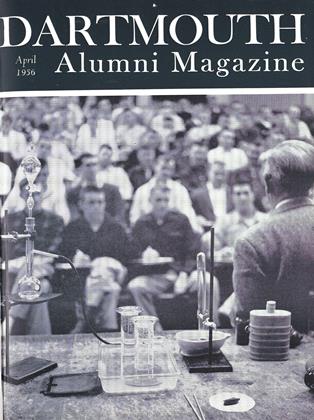By FrancisSteegmuller '27. New York: Farrar, Straus &Cudahy, 1956. 308 pp. $3.75.
Probably very few Americans have heard of Anne Marie Louise Henriette d'Orléans, the Grand Mademoiselle. It may safely be predicted, however, that Francis Steegmuller's biographical study of this great lady of the court of Louis XIV will ensure her a far broader fame than she has thus far enjoyed.
The daughter of Gaston d'Orléans, brother of Louis XIII, and Marie de Bourbon, Mademoiselle was first cousin to the Sun King himself. Politically speaking her great day came in 1652 during the rebellion against the rule of Cardinal Mazarin known as the Fronde. Joining the rebel forces this young lady of twenty-five displayed an audacity and power of rapid decision which deeply impressed friend and foe alike.
The theme of the book, however, is the problem of Mademoiselle's marriage. Blood and wealth made her the most desirable bride in all Europe. Marriage project followed marriage project. Nearly every crowned head or heir apparent of the day was at one time or another a candidate for her hand. There was even talk that she might marry Louis XIV himself. Yet for one reason or another all these glittering projects collapsed.
Then in 1659 Mademoiselle met the eccentric little Gascon, the Count de Lauzun. Gradually a love affair developed in which Mademoiselle at least was completely sincere. In 1671 Louis XIV actually consented to the marriage of the couple. Then Lauzun's enemies gained the king's ear and he changed his mind. Poor Mademoiselle was utterly crushed. As for Lauzun, he was imprisoned in the fortress of Pignerol. Released ten years later he returned to court, but his relations with Mademoiselle thereafter were marked by bitter and petty quarrels. Mademoiselle probably died an old maid, despite the inevitable tales that she and Lauzun had been secretly married.
Steegmuller's narrative is clear, direct, and very readable. Throughout he exercises laudable restraint and sound critical judgment. Thus he refrains from accepting at face value all the gossip of the court. Making skillful use of Mademoiselle's own Memoirs, he has succeeded in painting a vivid and convincing picture of a lady who had everything in the world except that which she wanted most.
 View Full Issue
View Full Issue
More From This Issue
-
 Feature
FeatureThe Hopkins Center Concept
April 1956 -
 Feature
FeatureTHE MOCK-DUEL MURDER
April 1956 By EDWARD CONNERY LATHEM '51 -
 Feature
FeatureELECTION-YEAR CONFERENCE
April 1956 By ROBERT H. GILE '56 -
 Feature
FeatureA Tuckerman Tradition
April 1956 By ROBERT S. MONAHAN '29 -
 Class Notes
Class Notes1918
April 1956 By ERNEST H. EARLEY, RICHARD A. HOLTON -
 Class Notes
Class Notes1929
April 1956 By CHRISTIAN E. BORN, JOHN W. MOXON
JOHN R. WILLIAMS
Books
-
 Books
BooksShelflife
Sept/Oct 2011 -
 Books
BooksCATHOLICS IN CONTROVERSY.
April 1955 By FRED BERTHOLD '45 -
 Books
BooksTHE U. S. EASTERN SKI ANNUAL
April1935 By John P. Carleton '22 -
 Books
BooksA SHORT HISTORY OF MIDWIFERY.
MAY 1965 By JOHN W. SCHLEICHER '40, M.D. -
 Books
BooksAN INTRODUCTION TO PUBLIC OPINION
July 1940 By Michael Choukas '27 -
 Books
BooksTHE IDEA OF PROGRESS IN AMERICA,
April 1945 By Robert E. Riegel.



